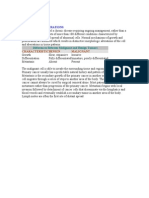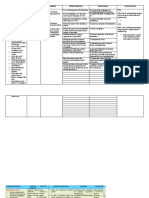67%(3)67% found this document useful (3 votes)
2K viewsNursing Care Plans For UTI
Nursing Care Plans For UTI
Uploaded by
Hannah PinUrinary tract infections (UTIs) are common and caused by bacterial entry through the urethra. Patients experience a variety of symptoms ranging from mild to severe, including urinary urgency, frequency, and pain. Nursing assessments include patient history to identify risk factors and a physical exam to check for signs of infection. Diagnostic tests identify the causative bacteria to guide appropriate antibiotic treatment. Nursing care plans aim to relieve symptoms, educate on prevention, ensure rest, treat the infection, and avoid complications or reinjury.
Copyright:
Attribution Non-Commercial (BY-NC)
Available Formats
Download as DOCX, PDF, TXT or read online from Scribd
Nursing Care Plans For UTI
Nursing Care Plans For UTI
Uploaded by
Hannah Pin67%(3)67% found this document useful (3 votes)
2K views2 pagesUrinary tract infections (UTIs) are common and caused by bacterial entry through the urethra. Patients experience a variety of symptoms ranging from mild to severe, including urinary urgency, frequency, and pain. Nursing assessments include patient history to identify risk factors and a physical exam to check for signs of infection. Diagnostic tests identify the causative bacteria to guide appropriate antibiotic treatment. Nursing care plans aim to relieve symptoms, educate on prevention, ensure rest, treat the infection, and avoid complications or reinjury.
Original Title
Nursing Care Plans for UTI
Copyright
© Attribution Non-Commercial (BY-NC)
Available Formats
DOCX, PDF, TXT or read online from Scribd
Share this document
Did you find this document useful?
Is this content inappropriate?
Urinary tract infections (UTIs) are common and caused by bacterial entry through the urethra. Patients experience a variety of symptoms ranging from mild to severe, including urinary urgency, frequency, and pain. Nursing assessments include patient history to identify risk factors and a physical exam to check for signs of infection. Diagnostic tests identify the causative bacteria to guide appropriate antibiotic treatment. Nursing care plans aim to relieve symptoms, educate on prevention, ensure rest, treat the infection, and avoid complications or reinjury.
Copyright:
Attribution Non-Commercial (BY-NC)
Available Formats
Download as DOCX, PDF, TXT or read online from Scribd
Download as docx, pdf, or txt
67%(3)67% found this document useful (3 votes)
2K views2 pagesNursing Care Plans For UTI
Nursing Care Plans For UTI
Uploaded by
Hannah PinUrinary tract infections (UTIs) are common and caused by bacterial entry through the urethra. Patients experience a variety of symptoms ranging from mild to severe, including urinary urgency, frequency, and pain. Nursing assessments include patient history to identify risk factors and a physical exam to check for signs of infection. Diagnostic tests identify the causative bacteria to guide appropriate antibiotic treatment. Nursing care plans aim to relieve symptoms, educate on prevention, ensure rest, treat the infection, and avoid complications or reinjury.
Copyright:
Attribution Non-Commercial (BY-NC)
Available Formats
Download as DOCX, PDF, TXT or read online from Scribd
Download as docx, pdf, or txt
You are on page 1of 2
Nursing care pIans for Urinary tract infections (UTs).
Urinary tract infections (UTs) are
common and usually occur because of the entry of bacteria into the urinary tract at the urethra
Nursing Assessment Nursing care pIans for Urinary tract infections (UTIs)
Patients History. The patient with a UT has a variety of symptoms that range from mild to
severe. The typical complaint is of one or more of the following: frequency, burning, urgency,
nocturia, blood or pus in the urine, and suprapubic fullness. The patient may complain of urinary
urgency and frequency, dysuria, bladder cramps or spasms, itching, a feeling of warmth during
urination, nocturia. Other complaints include low back pain, malaise, nausea, vomiting, pain or
tenderness over the bladder, chills, and flank pain. nflammation of the bladder wall also causes
hematuria and fever. Ask the patient about risk factors, including recent catheterization of the
urinary tract, pregnancy or recent childbirth, neurological problems, volume depletion, frequent
sexual activity, and presence of a sexually transmitted infection (ST).
PhysicaI Examination. Physical examination is often unremarkable in the patient with a UT,
although some patients have costovertebral angle tenderness in cases of pyelonephritis. On
occasion, the patient has fever, chills, and signs of a systemic infection. nspect the urine to
determine its color, clarity, odor, and character. Surveillance for STs is recommended as part of
the examination.
Diagnostic tests Urinary tract infections (UTIs).
Several tests are used to diagnose lower UTs:
O Leukocyte esterase dip test
O Clean-catch urinalysis.
O Clean-catch collection is preferred to catheterization, which can reinfect the bladder with
urethral bacteria.
O Sensitivity testing is used to determine the appropriate antimicrobial drug.
O Stained smear of urethral discharge can be used to rule out sexually transmitted disease.
O Voiding cystourethrography or excretory urography
Nursing diagnosis Nursing care pIans for Urinary tract infections (UTIs).
O Acute pain
O Deficient knowledge (prevention)
O Disturbed sleep pattern
O mpaired urinary elimination
O Risk for infection
O Risk for injury
O Sexual dysfunction
Nursing Key outcomes Nursing care pIans for Urinary tract infections (UTIs)
The patients wiII:
O Report increased comfort.
O dentify risk factors that exacerbate the disease process or condition and modify his lifestyle
accordingly.
O Verbalize feeling well rested after undisturbed periods of sleep.
O Remain free from signs or symptoms of infection.
O Avoid or minimize complications.
O Reestablish sexual activity at the preillness level.
O Patient and family will demonstrate skill in managing elimination problem.
You might also like
- Marquez - Case Study 4Document4 pagesMarquez - Case Study 4Caren MarquezNo ratings yet
- 10 CaritosDocument3 pages10 CaritosDARREN EDMARK100% (4)
- Deficient Knowledge: Nursing Diagnosis Nursing Care Plans (NCP)Document3 pagesDeficient Knowledge: Nursing Diagnosis Nursing Care Plans (NCP)Vincent Paul SantosNo ratings yet
- Ati Codes Cont'Document1 pageAti Codes Cont'm1k0eNo ratings yet
- Chapter 57 Introduction To The Urinary SystemDocument24 pagesChapter 57 Introduction To The Urinary SystemtikkimarshallNo ratings yet
- Nursing Care PlanllDocument5 pagesNursing Care Planllbbarnes0912No ratings yet
- Urinary Tract Infection, (UTI) Is An Infection of One orDocument4 pagesUrinary Tract Infection, (UTI) Is An Infection of One orLorebellNo ratings yet
- Gastric Outlet Obstruction, A Simple Guide To The Condition, Diagnosis, Treatment And Related ConditionsFrom EverandGastric Outlet Obstruction, A Simple Guide To The Condition, Diagnosis, Treatment And Related ConditionsNo ratings yet
- Genitourinary SystemDocument27 pagesGenitourinary SystemDanica FrancoNo ratings yet
- Ineffective Tissue Perfusion Nursing Care PlanDocument1 pageIneffective Tissue Perfusion Nursing Care PlankimmybapkiddingNo ratings yet
- Concept Map CholesectomyDocument3 pagesConcept Map CholesectomyDoreen Claire100% (1)
- Plan of Care For:: Nursing Diagnosis: Excess Fluid VolumeDocument3 pagesPlan of Care For:: Nursing Diagnosis: Excess Fluid VolumeKenji CadizNo ratings yet
- Acute and Chronic GastritisDocument6 pagesAcute and Chronic GastritisAnn CanNo ratings yet
- Discharge PlanDocument2 pagesDischarge PlanMaureenAmilcaNo ratings yet
- Constipation 508Document12 pagesConstipation 508Shishir Kumar SinghNo ratings yet
- Nursing Care Plan Renal FailureDocument18 pagesNursing Care Plan Renal FailureKundan KumarNo ratings yet
- Nursing SkillDocument1 pageNursing SkillMarina Wasem NetzlaffNo ratings yet
- CHF Cardiomegaly Volume OverloadDocument1 pageCHF Cardiomegaly Volume Overloadnursing concept mapsNo ratings yet
- Cellulitis Concept MapDocument3 pagesCellulitis Concept MapBien EstrellaNo ratings yet
- Medication - ALT-Template Polythene GlycolDocument1 pageMedication - ALT-Template Polythene GlycolNancyAmissahNo ratings yet
- Nursing Diagnosis: Urinary Retention: NOC Outcomes (Nursing Outcomes Classification)Document4 pagesNursing Diagnosis: Urinary Retention: NOC Outcomes (Nursing Outcomes Classification)rem_No ratings yet
- Nursing Care Plan & Drug Study Set #1: PneumoniaDocument6 pagesNursing Care Plan & Drug Study Set #1: PneumoniaBakushidoNo ratings yet
- Case Study 114: ScenarioDocument4 pagesCase Study 114: ScenarioPrincess Levie CenizaNo ratings yet
- Teaching P AnemiaDocument3 pagesTeaching P AnemiaFiona Cheryl Amsterdam50% (2)
- CASE SIMUlation 112Document6 pagesCASE SIMUlation 112Princess Levie CenizaNo ratings yet
- DX Infective Endocarditis PDFDocument7 pagesDX Infective Endocarditis PDFSherree HayesNo ratings yet
- PrevacidDocument1 pagePrevacidAdrianne BazoNo ratings yet
- Waiters Rhabdomyolysis PDFDocument1 pageWaiters Rhabdomyolysis PDFTommieNo ratings yet
- Feliciano, Troy Ivan Silva, Queenie Rose V. BSN 3-C: Rationale: To Track The Changes of Client's ConditionDocument4 pagesFeliciano, Troy Ivan Silva, Queenie Rose V. BSN 3-C: Rationale: To Track The Changes of Client's ConditionQueenie SilvaNo ratings yet
- The Infant Should Always Be in A Rear-Facing Car Seat From Birth To 9.1 KGDocument7 pagesThe Infant Should Always Be in A Rear-Facing Car Seat From Birth To 9.1 KGSabhi Sandhu100% (1)
- Final Peds Concept MapDocument9 pagesFinal Peds Concept Mapapi-495456666No ratings yet
- NCP Acute Pain NCSDocument3 pagesNCP Acute Pain NCSPaolo Vittorio Perdigueros GonzalesNo ratings yet
- Liver Cirrhosis Care PlanDocument3 pagesLiver Cirrhosis Care PlanWendy EscalanteNo ratings yet
- Abbreviation NursingDocument16 pagesAbbreviation NursingPeter Lucky Turiano100% (1)
- Nanda Needs ListDocument24 pagesNanda Needs ListObrian ReidNo ratings yet
- Discharge Plan EndoDocument3 pagesDischarge Plan EndoCharlayne AnneNo ratings yet
- Mushtaq Ahmad: Running Head: REFLECTIVE LOG 1Document5 pagesMushtaq Ahmad: Running Head: REFLECTIVE LOG 1Shafiq Ur RahmanNo ratings yet
- Malnutrition in Older AdultsDocument44 pagesMalnutrition in Older Adultsjohnjoe subaynoNo ratings yet
- Cancer NursingDocument53 pagesCancer Nursingfairwoods100% (1)
- Nursing Care PlanDocument16 pagesNursing Care PlanMelody B. MiguelNo ratings yet
- Propranolol 1 PresentationDocument17 pagesPropranolol 1 Presentationapi-284092317100% (1)
- Assessment Nursing Diagnosis Planning Intervention Rationale EvaluationDocument4 pagesAssessment Nursing Diagnosis Planning Intervention Rationale EvaluationMara Jon Ocden CasibenNo ratings yet
- Intra-Abdominal HypertensionDocument3 pagesIntra-Abdominal HypertensionClark SavageNo ratings yet
- Nursing Care PlanDocument13 pagesNursing Care Planyumiko0% (1)
- Acute GastroenteritisDocument13 pagesAcute Gastroenteritismarjorie_11No ratings yet
- Discharge Planning PaperDocument5 pagesDischarge Planning Paperapi-283173905No ratings yet
- Nursing Diagnosis: Risk For Deficient Fluid Volume R/T Traumatic InjuryDocument2 pagesNursing Diagnosis: Risk For Deficient Fluid Volume R/T Traumatic Injuryarreane yookNo ratings yet
- Medicine Ward NCPDocument11 pagesMedicine Ward NCPKimsha ConcepcionNo ratings yet
- NCP and Drug StudyDocument9 pagesNCP and Drug StudyJHoy JhoyThotNo ratings yet
- Imbalanced Nutrition: Less Than Body RequirementDocument10 pagesImbalanced Nutrition: Less Than Body RequirementDangz SkiiNo ratings yet
- NCLEX CardiovascularDocument93 pagesNCLEX CardiovascularYaoling WenNo ratings yet
- Ventricular Septal Defect, A Simple Guide To The Condition, Treatment And Related ConditionsFrom EverandVentricular Septal Defect, A Simple Guide To The Condition, Treatment And Related ConditionsNo ratings yet
- Nursing Care PlanDocument3 pagesNursing Care PlanCrystelle MonaresNo ratings yet
- Brain Infarction NCPDocument3 pagesBrain Infarction NCPJasmn DingleNo ratings yet
- Nursing Care CKDDocument17 pagesNursing Care CKDUlLfa Chii MuetmuethzNo ratings yet
- Nursing Care Plan - MergedDocument13 pagesNursing Care Plan - MergedJuls Flares SycaycoNo ratings yet
- Acute Myocardial InfarctionDocument10 pagesAcute Myocardial InfarctionBianca Watanabe - RatillaNo ratings yet
- FHN - Nursing Care Plan Constipation)Document3 pagesFHN - Nursing Care Plan Constipation)blahniksNo ratings yet
- Cultural Competence and Perceptions of Filipino Nurses On Effectiveness of Reducing Health Care DisparitiesDocument7 pagesCultural Competence and Perceptions of Filipino Nurses On Effectiveness of Reducing Health Care DisparitiesChristine Elaine Batusin IlaganNo ratings yet



























































